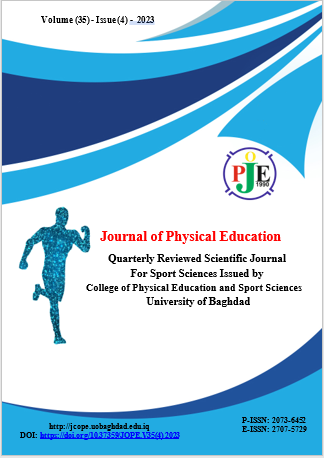The effect of using the flipped classroom with mobile learning technology on the performance level of some skills Gymnastics for students of the Department of Physical Education at Umm Al-Qura University
DOI:
https://doi.org/10.37359/JOPE.V35(4)2023.1947الكلمات المفتاحية:
Flipped Classroom، Mobile Learningالملخص
The flipped classroom is a teaching strategy used to improve the learning experience for students. This strategy is implemented in classrooms by giving students responsibility for learning and discovery and shifting the active role in learning from teachers to students. The flipped classroom is used in education with a variety of educational fields, including mobile learning. The aim of this study was to find out the effect of using the flipped classroom with mobile learning technology on the level of performance of some skills in gymnastics for students of the Physical Education Department (PED). The study sample consisted of (36) students from PED, who had no experience in the skills under study. The experimental method with a design was used. The study group consists of two groups, control and experimental, of equal numbers. The research was applied during the first semester of 1443 AH for a period of (12) weeks, with three educational units for each skill, preceded by a week of pre-measurements and post-measurements. The results showed significant differences between the dimensional measurements of the two groups, in favor of the experimental group. The use of the flipped classroom with the mobile learning technique had a significant improvement in teaching the gymnastics skills to the experimental group compared to the control group that used the traditional method. The researcher recommends the need to use the flipped classroom with mobile learning technology in teaching gymnastics skills on different devices and in teaching different individual and group sports skills.
المراجع
Alvarez, Brenda. (2012). Flipping the Classroom: homework in class, lessons at home, National Education Association. Retrieved 22 February.
Heng, Ngee. (2014). Teaching tip: the flipped classroom. The Journal of Information Systems Education, Vol. 25(1) j7-11, Spring.
Hof, Stetter. (2005). Multimedia Literacy", New York, Mc Grqw-hill.
Mousa, A. M., & Kadhim, M. J. (2023). NMUSING AN INNOVATIVE DEVICE TO IMPROVE THE EFFICIENCY OF THE ANTERIOR QUADRICEPS MUSCLE OF THE INJURED KNEE JOINT AFTER SURGICAL INTERVENTION OF THE ANTERIOR CRUCIATE LIGAMENT IN ADVANCED SOCCER PLAYERS. Semiconductor Optoelectronics, 42(1), 1504–1511.
Keskin, N., & Metcalf, D. (2011). The current perspectives, theories and practices of mobile learning, the Turkish online journal of educational technology (TOJET), 10 (2), pp 202-208.
Rong-Mei, Peng. (2015). A study on the history, current situation, and application of "flipped classroom", China Educational Technology, (7), 108-115.
Sweet, Dawn. (2013). Micro lectures in a flipped classroom: Application, Creation and Resources, Mid-Western Educational Researcher. Vol 26, Issue 1, pp52-59.
Tina, Barseghian. (2011). Three Trends That Define the Future of Teaching and Learning, KQED.
التنزيلات
منشور
إصدار
القسم
الرخصة
الحقوق الفكرية (c) 2023 Journal of Physical Education

هذا العمل مرخص بموجب Creative Commons Attribution 4.0 International License.






